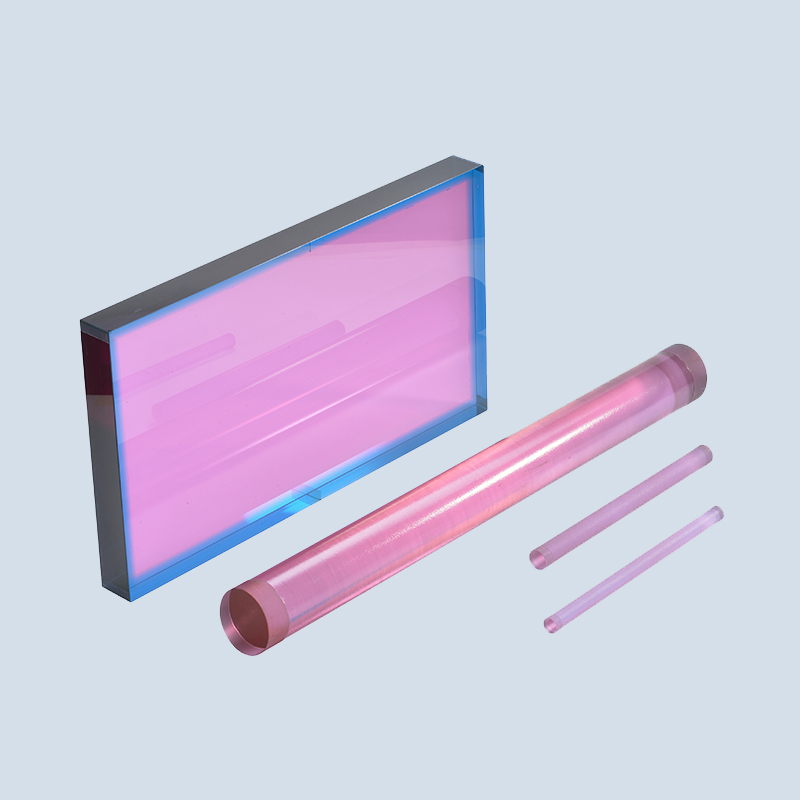 |
Laser glass based on silicate and phosphate
Laser glasses on both silicate and phosphate bases, activated with neodymium with different activator
concentrations, have been developed.
Part number:
Supplier:
Shvabe Description
Silicate glasses have a high temperature resistance and a longer duration of luminescence compared to
phosphate glasses.
Phosphate glasses have higher cross-sections of stimulated radiation and lower values of thermo-optical
constants in comparison with silicate glasses.
Improving the quality of all types of laser glasses contributes to increasing the thermal strength of the
active elements, which in turn is achieved by various processing rods (quenching, ion exchange,
protective coatings).
Heat treatment of rods also allows you to create anisotropy in them, compensating for those
inhomogeneities that will occur during the operation of the element.
The main official document for neodymium glass is the industry standard of glass OST 3-30-70.
Neodymium glasses are designated by the letters GLS-generating luminescent glass.
All brands of neodymium glass from GLS1 to GLS14 inclusive have a silicate base, gls21 - GLS24 —
phosphate.
The purpose (scope):
Neodymium-activated glasses capable of generating stimulated radiation are widely used as active
media for solid-state lasers.
Generating luminescent glass (GLS) is a solid phosphor, used as the active medium of solid-state lasers,
normalized by the indicator of activator absorption (preim. neodymium), the luminescence decay time
and the absorption index at the generation wavelength of 1.06 microns (inactive absorption).
Main types of deliveries:
The set of standard rods of different cross-sectional shape (cylindrical, rectangular) and angle parallel to
each other ends (perpendicular to the rod at a slight angle, Brewster angle).
Round rods made of neodymium glass are commercially available in diameters Ø5-60mm and length 80-
1200mm.
Perpendicular to the rod ends are parallel to each other no worse than 10”, and Brewster and beveled-
no worse than 2’.
A fundamental change in the technology of phosphate neodymium glasses, conducted in JSC LZOS,
allowed to organize the production of large-size active elements from laser phosphate glass brand KNFS-
3
Parameters of the main properties of the laser glass brand KNFS-3:
Concentration of neodymium ions, cm-3 3,5·1020
The cross section for stimulated emission, σ·1020 cm2 3,8
The duration of the decay of the luminescence, τ ISS ≥310
Nonlinear refractive index, sgse unit 1.15±3
Coefficient of thermal linear expansion
α ·107 (K-1) in the range (20-300)°C 115±3
Density, g/cm3 2.87
The absorption coefficient at the working wavelength
λ=1.0535 µm (cm-1) ≤0.0009
Produced at JSC " lytkarinsky optical glass plant"
phosphate glasses.
Phosphate glasses have higher cross-sections of stimulated radiation and lower values of thermo-optical
constants in comparison with silicate glasses.
Improving the quality of all types of laser glasses contributes to increasing the thermal strength of the
active elements, which in turn is achieved by various processing rods (quenching, ion exchange,
protective coatings).
Heat treatment of rods also allows you to create anisotropy in them, compensating for those
inhomogeneities that will occur during the operation of the element.
The main official document for neodymium glass is the industry standard of glass OST 3-30-70.
Neodymium glasses are designated by the letters GLS-generating luminescent glass.
All brands of neodymium glass from GLS1 to GLS14 inclusive have a silicate base, gls21 - GLS24 —
phosphate.
The purpose (scope):
Neodymium-activated glasses capable of generating stimulated radiation are widely used as active
media for solid-state lasers.
Generating luminescent glass (GLS) is a solid phosphor, used as the active medium of solid-state lasers,
normalized by the indicator of activator absorption (preim. neodymium), the luminescence decay time
and the absorption index at the generation wavelength of 1.06 microns (inactive absorption).
Main types of deliveries:
The set of standard rods of different cross-sectional shape (cylindrical, rectangular) and angle parallel to
each other ends (perpendicular to the rod at a slight angle, Brewster angle).
Round rods made of neodymium glass are commercially available in diameters Ø5-60mm and length 80-
1200mm.
Perpendicular to the rod ends are parallel to each other no worse than 10”, and Brewster and beveled-
no worse than 2’.
A fundamental change in the technology of phosphate neodymium glasses, conducted in JSC LZOS,
allowed to organize the production of large-size active elements from laser phosphate glass brand KNFS-
3
Parameters of the main properties of the laser glass brand KNFS-3:
Concentration of neodymium ions, cm-3 3,5·1020
The cross section for stimulated emission, σ·1020 cm2 3,8
The duration of the decay of the luminescence, τ ISS ≥310
Nonlinear refractive index, sgse unit 1.15±3
Coefficient of thermal linear expansion
α ·107 (K-1) in the range (20-300)°C 115±3
Density, g/cm3 2.87
The absorption coefficient at the working wavelength
λ=1.0535 µm (cm-1) ≤0.0009
Produced at JSC " lytkarinsky optical glass plant"